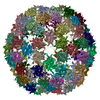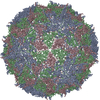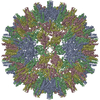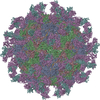[English] 日本語
 Yorodumi
Yorodumi- PDB-6n4v: CryoEM structure of Leviviridae PP7 WT coat protein dimer capsid ... -
+ Open data
Open data
- Basic information
Basic information
| Entry | Database: PDB / ID: 6n4v | ||||||
|---|---|---|---|---|---|---|---|
| Title | CryoEM structure of Leviviridae PP7 WT coat protein dimer capsid (PP7PP7-WT) | ||||||
 Components Components | Coat protein | ||||||
 Keywords Keywords |  VIRUS LIKE PARTICLE / T4 / VIRUS LIKE PARTICLE / T4 /  icosahedral / PP7 / biotechnology / icosahedral / PP7 / biotechnology /  vaccine / vaccine /  drug delivery drug delivery | ||||||
| Function / homology | Bacteriophage PP7, coat / Phage PP7 coat protein / Bacteriophage RNA-type, capsid / T=3 icosahedral viral capsid /  regulation of translation / regulation of translation /  RNA binding / identical protein binding / RNA binding / identical protein binding /  Capsid protein Capsid protein Function and homology information Function and homology information | ||||||
| Biological species |  Pseudomonas phage PP7 (virus) Pseudomonas phage PP7 (virus) | ||||||
| Method |  ELECTRON MICROSCOPY / ELECTRON MICROSCOPY /  single particle reconstruction / single particle reconstruction /  cryo EM / Resolution: 3 Å cryo EM / Resolution: 3 Å | ||||||
 Authors Authors | Liangjun, Z. / Kopylov, M. / Potter, C.S. / Carragher, B. / Finn, M.G. | ||||||
| Funding support |  United States, 1items United States, 1items
| ||||||
 Citation Citation |  Journal: ACS Nano / Year: 2019 Journal: ACS Nano / Year: 2019Title: Engineering the PP7 Virus Capsid as a Peptide Display Platform. Authors: Liangjun Zhao / Mykhailo Kopylov / Clinton S Potter / Bridget Carragher / M G Finn /  Abstract: As self-assembling polyvalent nanoscale structures that can tolerate substantial genetic and chemical modification, virus-like particles are useful in a variety of fields. Here we describe the ...As self-assembling polyvalent nanoscale structures that can tolerate substantial genetic and chemical modification, virus-like particles are useful in a variety of fields. Here we describe the genetic modification and structural characterization of the Leviviridae PP7 capsid protein as a platform for the presentation of functional polypeptides. This particle was shown to tolerate the display of sequences from 1 kDa (a cell penetrating peptide) to 14 kDa (the Fc-binding double Z-domain) on its exterior surface as C-terminal genetic fusions to the coat protein. In addition, a dimeric construct allowed the presentation of exogenous loops between capsid monomers and the simultaneous presentation of two different peptides at different positions on the icosahedral structure. The PP7 particle is thereby significantly more tolerant of these types of polypeptide additions than Qβ and MS2, the other Leviviridae-derived VLPs in common use. | ||||||
| History |
|
- Structure visualization
Structure visualization
| Movie |
 Movie viewer Movie viewer |
|---|---|
| Structure viewer | Molecule:  Molmil Molmil Jmol/JSmol Jmol/JSmol |
- Downloads & links
Downloads & links
- Download
Download
| PDBx/mmCIF format |  6n4v.cif.gz 6n4v.cif.gz | 4.8 MB | Display |  PDBx/mmCIF format PDBx/mmCIF format |
|---|---|---|---|---|
| PDB format |  pdb6n4v.ent.gz pdb6n4v.ent.gz | Display |  PDB format PDB format | |
| PDBx/mmJSON format |  6n4v.json.gz 6n4v.json.gz | Tree view |  PDBx/mmJSON format PDBx/mmJSON format | |
| Others |  Other downloads Other downloads |
-Validation report
| Arichive directory |  https://data.pdbj.org/pub/pdb/validation_reports/n4/6n4v https://data.pdbj.org/pub/pdb/validation_reports/n4/6n4v ftp://data.pdbj.org/pub/pdb/validation_reports/n4/6n4v ftp://data.pdbj.org/pub/pdb/validation_reports/n4/6n4v | HTTPS FTP |
|---|
-Related structure data
| Related structure data |  0344MC  0351C  0352C  0353C  0354C M: map data used to model this data C: citing same article ( |
|---|---|
| Similar structure data |
- Links
Links
- Assembly
Assembly
| Deposited unit | 
|
|---|---|
| 1 |
|
- Components
Components
| #1: Protein | Mass: 28144.008 Da / Num. of mol.: 120 Source method: isolated from a genetically manipulated source Source: (gene. exp.)  Pseudomonas phage PP7 (virus) / Production host: Pseudomonas phage PP7 (virus) / Production host:   Escherichia coli (E. coli) / References: UniProt: Q38062 Escherichia coli (E. coli) / References: UniProt: Q38062 |
|---|
-Experimental details
-Experiment
| Experiment | Method:  ELECTRON MICROSCOPY ELECTRON MICROSCOPY |
|---|---|
| EM experiment | Aggregation state: PARTICLE / 3D reconstruction method:  single particle reconstruction single particle reconstruction |
- Sample preparation
Sample preparation
| Component | Name: Pseudomonas phage PP7 / Type: VIRUS / Entity ID: all / Source: RECOMBINANT |
|---|---|
| Source (natural) | Organism:  Pseudomonas phage PP7 (virus) Pseudomonas phage PP7 (virus) |
| Source (recombinant) | Organism:   Escherichia coli (E. coli) Escherichia coli (E. coli) |
| Details of virus | Empty: YES / Enveloped: NO / Isolate: SPECIES / Type: VIRUS-LIKE PARTICLE |
| Buffer solution | pH: 7.4 |
| Specimen | Conc.: 1 mg/ml / Embedding applied: NO / Shadowing applied: NO / Staining applied : NO / Vitrification applied : NO / Vitrification applied : YES : YES |
| Specimen support | Details: unspecified |
Vitrification | Cryogen name: ETHANE |
- Electron microscopy imaging
Electron microscopy imaging
| Experimental equipment |  Model: Titan Krios / Image courtesy: FEI Company |
|---|---|
| Microscopy | Model: FEI TITAN KRIOS |
| Electron gun | Electron source : :  FIELD EMISSION GUN / Accelerating voltage: 300 kV / Illumination mode: FLOOD BEAM FIELD EMISSION GUN / Accelerating voltage: 300 kV / Illumination mode: FLOOD BEAM |
| Electron lens | Mode: BRIGHT FIELD Bright-field microscopy / Nominal magnification: 22500 X / Nominal defocus min: 2 nm / Cs Bright-field microscopy / Nominal magnification: 22500 X / Nominal defocus min: 2 nm / Cs : 2.7 mm / C2 aperture diameter: 70 µm / Alignment procedure: COMA FREE : 2.7 mm / C2 aperture diameter: 70 µm / Alignment procedure: COMA FREE |
| Specimen holder | Cryogen: NITROGEN |
| Image recording | Electron dose: 35 e/Å2 / Detector mode: COUNTING / Film or detector model: GATAN K2 SUMMIT (4k x 4k) |
- Processing
Processing
| EM software |
| ||||||||||||||||||||||||||||
|---|---|---|---|---|---|---|---|---|---|---|---|---|---|---|---|---|---|---|---|---|---|---|---|---|---|---|---|---|---|
CTF correction | Type: PHASE FLIPPING AND AMPLITUDE CORRECTION | ||||||||||||||||||||||||||||
| Symmetry | Point symmetry : I (icosahedral : I (icosahedral ) ) | ||||||||||||||||||||||||||||
3D reconstruction | Resolution: 3 Å / Resolution method: FSC 0.143 CUT-OFF / Num. of particles: 33224 / Num. of class averages: 5 / Symmetry type: POINT |
 Movie
Movie Controller
Controller










 PDBj
PDBj

